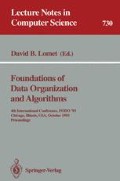Abstract
In many existing hypertext systems, a navigation mechanism is provided as the main facility so that readers can search the contents. In order to expand the ability of searching, in this paper we propose a query mechanism to be used in addition to the ordinary navigation mechanism. We can express the advanced abilities of searching by combining the query mechanism with the navigation mechanism. These query expressions can be used to provide the user's point of view besides the designer's point of view, which was previously defined by the links among nodes. Especially, an environment that changes dynamically in correspondence with the user's navigation can be described when one uses our query mechanism. Since the mechanisms proposed in this paper are defined in a formal way, they can be applied to various practical hypertext systems.
Preview
Unable to display preview. Download preview PDF.
References
Abiteboul, S., and Grumbach, S. COL: A Logic-Based Language for Complex Objects. In Workshop on Database Programming Languages (1987), pp. 253–276.
Afrati, F., and Koutras, C. D. A Hypertext Model Supporting Query Mechanisms. In Hypertext: Concepts, Systems and Applications, N. Streitz, A. Rizk, and J. André, Eds., Cambridge University Press, Cambridge, UK, 1990, pp. 52–66. Proceedings of the European Conference on Hypertext.
Beeri, C., and Kornatzky, Y. A Logical Query Language for Hypertext Systems. In Hypertext: Concepts, Systems and Applications, N. Streitz, A. Rizk, and J. André, Eds., Cambridge University Press, Cambridge, UK, 1990, pp. 67–80. Proceedings of the European Conference on Hypertext.
Berge, C. Graphs and Hypergraphs. American Elsevier, New York, 1973.
Campbell, B., and Goodman, J. M. HAM: A General Purpose Hypertext Abstract Machine. Communications of the ACM 31, 7 (July 1988), 856–861.
Chen, W., Kifer, M., and Warren, D. S. HiLog as a Platform for Database Languages (or why predicate calculus is not enough). In Proceedings of the 2nd International Workshop on Database Programming Languages (1989), R. Hull, R. Morrison, and D. Stemple, Eds., Morgan Kaufmann Publishers, pp. 315–329.
Cluet, S., Delobel, C., Lécluse, C., and Richard, P. Reloop, an Algebra Based Query Language for an Object-Oriented Database System. In Proceedings of the 1st Conference on Deductive and Object-Oriented Databases (1989), pp. 294–313.
Garg, P. K. Abstraction mechanisms in hypertext. Communications of the ACM 31, 7 (July 1988), 862–870.
Halasz, F. G. Reflections on NoteCards: Seven Issues for the Next Generation of Hypermedia Systems. Communications of the ACM 31, 7 (July 1988), 836–852.
Kahn, G. Natural Semantics. In Proceedings of 4th Annual Symposium on Theoretical Aspects of Computer Science (1987), G. Goos and J. Hartmanis, Eds., Springer-Verlag, pp. 22–39. LNCS Volume 247.
Kifer, M., and Lausen, G. F-logic: A higher-order language for reasoning about objects, inheritance and schema. In Proceedings of the ACM Symposium on Principles of Database Systems (1989), ACM Press, pp. 231–239.
Meyrowitz, N. Hypermedia and the Desktop of Tomorrow. In FRIEND21 Workshop (October 1990).
Minker, J., Ed. Foundations of Deductive Databases and Logic Programming. Morgan Kaufmann Publishers, 1988.
Reiter, R. “Towards a Logical Reconstruction of Relational Database Theory”. In On Conceptual Modelling, M. L. Brodie, J. Mylopoulos, and J. W. Schmidt, Eds., Springer-Verlag, 1984, ch. 8, pp. 191–238.
Schütt, H., and Streitz, N. A. Hyper Base: A Hypermedia Engine based on a Relational Database Management System. Arbeitspapiere der GMD 469, Gesellschaft fur Mathematik und Datenverarbeitung mbH, July 1990.
Shaw, G., and Zdonik, S. An Object-Oriented Query Algebra. In Proceedings of the 2nd International Workshop on Database Programming Languages (1989), R. Hull, R. Morrison, and D. Stemple, Eds., Morgan Kaufmann Publisher, pp. 103–112.
Tompa, F. W. A Data Model for Flexible Hypertext Database Systems. ACM Transactions on Information Systems 7, 1 (January 1989), 85–100.
Trigg, R. H. Guided Tours and Tabletops: Tools for Communicationg in a Hypertext Environment. ACM Transactions on Office Information Systems 6, 4 (October 1988), 398–414.
Ullman, J. D. “Principles of Database and Knowledge Base Systems”. Vol. 1,2, Computer Science Press, 1988.
Watanabe, R. Query and Views in Hypertext. Master's thesis, Keio University, Department of Computer Science, 1993. written in Japanese. English paper will appear.
Author information
Authors and Affiliations
Editor information
Rights and permissions
Copyright information
© 1993 Springer-Verlag Berlin Heidelberg
About this paper
Cite this paper
Minohara, T., Watanabe, R., Tokoro, M. (1993). Queries on structures in hypertext. In: Lomet, D.B. (eds) Foundations of Data Organization and Algorithms. FODO 1993. Lecture Notes in Computer Science, vol 730. Springer, Berlin, Heidelberg. https://doi.org/10.1007/3-540-57301-1_27
Download citation
DOI: https://doi.org/10.1007/3-540-57301-1_27
Published:
Publisher Name: Springer, Berlin, Heidelberg
Print ISBN: 978-3-540-57301-2
Online ISBN: 978-3-540-48047-1
eBook Packages: Springer Book Archive

